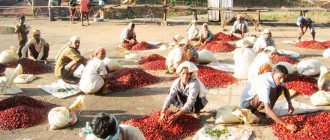Everything in the world has its source. Ethiopia became the starting point for the history of coffee in the human world. It was here that those same legendary goats grazed and pointed out the invigorating red berries to their shepherd. It was here that they learned to process and cook these berries. Ethiopian coffee gave birth to most of the currently known varieties and varieties. This country remains the birthplace of excellent Arabica beans today. Ethiopia produces the best varieties, which many gourmets confidently rank first in terms of taste. Let's lift the lid on the coffee history of mysterious Abyssinia and try to unravel the secret of real Ethiopian coffee.
History of Coffee in Ethiopia
Even in ancient times, people began to consume parts of the coffee tree in their diet. And the first to discover coffee were the Ethiopians - a population living before our era in the province of Kaffa - this is Ethiopia in our time.
The fruits were crushed and combined with animal fat; edible balls were formed from this mass, which they carried with them to refresh themselves. The juice extracted from the fruit was used to prepare a drink reminiscent of wine, and the leaves were brewed to produce an analogue of tea.
Only over time, Ethiopians began to heat water and use coffee beans to prepare the drink. Such drinks were initially part of rituals associated with religion. And Ethiopian coffee became a drink of national importance much later, a national drink. Wood processing: the process of collecting leaves and grains, has become a separate craft.
Ethiopia is the birthplace of coffee
According to ancient legends, a resident from the province of Kaffa, while grazing a herd of goats, discovered strange berries. Having tried them, he felt cheerfulness and energy, so he hastened to share his find with the believing hermit.
He did not listen to the shepherd and ordered to immediately get rid of the hellish fruits by throwing them into the fire. But everything changed when the aroma of coffee began to spread throughout the area, they began to take out grains and fire and pour water on them. So, by absolute chance, they discovered the original drink.
Ethiopia Nyala
Purchase history
- Frequency of purchases: ~ every week
- Collection duration: ~ 4-6 days
| date | Delivery from | Collection theme |
| 15.09.19 | Nizhny Novgorod region. | Collection until September 20th. Promotion from T asty C of fe, coffee and tea of different flavors, and now capsules.-166 |
| 07.09.19 | Nizhny Novgorod region. | Collection until September 13th. Promotion from T asty C of fe, coffee and tea of different flavors, and now capsules.-165 |
| 03.09.19 | Nizhny Novgorod region. | Collection until September 6th. Promotion from T asty C of fe, coffee and tea of different flavors, and now capsules.-164 |
| 24.08.19 | Nizhny Novgorod region. | Collection until August 30th. Promotion from T asty C of fe, coffee and tea of different flavors, and now capsules.-163 |
| 18.08.19 | Nizhny Novgorod region. | Collection until August 23rd. Promotion from T asty C of fe, coffee and tea of different flavors, and now capsules.-162 |
| 11.08.19 | Nizhny Novgorod region. | Collection until August 16th. Promotion from T asty S of fe, coffee and tea of different flavors, and now capsules.-161 |
| 04.08.19 | Nizhny Novgorod region. | Collection until August 9th. Promotion from T asty C of fe, coffee and tea of different flavors, and now capsules.-160 |
| 27.07.19 | Nizhny Novgorod region. | Collection until August 2. Promotion from T asty C of fe, coffee and tea of different flavors, and now capsules.-159 |
| 20.07.19 | Nizhny Novgorod region. | Collection until July 26. Promotion from T asty C of fe, coffee and tea of different flavors, and now capsules.-158 |
| 15.07.19 | Nizhny Novgorod region. | Collection until July 19. Promotion from T asty C of fe, coffee and tea of different flavors, and now capsules.-157 |
| 05.07.19 | Nizhny Novgorod region. | Collection until July 5th. Promotion from T asty C of fe, coffee and tea of different flavors, and now capsules.-156 |
| 02.07.19 | Nizhny Novgorod region. | Collection until July 5th. Promotion from T asty C of fe, coffee and tea of different flavors, and now capsules.-155 |
| 22.06.19 | Nizhny Novgorod region. | Collection until June 28th. Promotion from T asty C of fe, coffee and tea of different flavors, and now capsules.-154 |
| 14.06.19 | Nizhny Novgorod region. | Collection until June 21st. Promotion from T asty C of fe, coffee and tea of different flavors, and now capsules.-153 |
| 09.06.19 | Nizhny Novgorod region. | Collection until June 14. Promotion from T asty S of fe, coffee and tea of different flavors, and now capsules.-152 |
| 01.06.19 | Nizhny Novgorod region. | Collection until June 7th. Promotion from T asty C of fe, coffee and tea of different flavors, and now capsules.-151 |
| 27.05.19 | Nizhny Novgorod region. | Collection until May 31st. Promotion from T asty C of fe, coffee and tea of different flavors, and now capsules.-150 |
| 17.05.19 | Nizhny Novgorod region. | Collection until May 24th. Promotion from T asty C of fe, coffee and tea of different flavors, and now capsules.-149 |
| 09.05.19 | Nizhny Novgorod region. | Collection until May 17th. Promotion from T asty S of fe, coffee and tea of different flavors, and now capsules.-148 |
| 28.04.19 | Nizhny Novgorod region. | Collection until May 8th. Promotion from T asty C of fe, coffee and tea of different flavors, and now capsules.-147 |
View all Hide
Growing and processing conditions
Ethiopia is a country, the main part of which is located at an altitude of one and a half kilometers above sea level. Basically, profitable products are produced on small farms, with a volume of more than three hundred thousand tons per year.
The country's tropical climate is optimal for growing coffee trees. Locals are engaged in harvesting from August, until January. The main variety of Ethiopian coffee grown here is Arabica, although its varieties are also found in some areas of the country.
Most of the coffee trees grew in nature on their own, and people only had to pick the ripe berries. This wild Arabica, devoid of care, produces a small harvest, and it is very difficult to collect berries in the thickets of the forest, so it is possible to obtain about twenty kilograms of raw materials per day.
About a third of the total harvest is harvested in special prepared areas. The soil is fertilized with special substances without using chemical components.
The local authorities did not deign to produce the necessary documents for Ethiopian coffee, so export occurs without the appropriate certificates.
Coffee cultivation in Ethiopia is facilitated by favorable climatic and landscape conditions - namely:
- special natural conditions - provides natural watering in the form of rain, and excellent protection from the sun - huge trees,
- mountainous terrain and soil near volcanoes, very fertile,
- absence of bad weather events and sudden temperature changes.
Ethiopia grows most of its coffee beans not on plantations, but in forests:
- wild trees are profitable because they produce the harvest themselves and producers do not have to plant seedlings. The soil near the volcanoes provides fertilizer and the rain provides watering.
- The disadvantage of wild coffee trees is that they grow at different heights and harvesting cannot be automated. This creates enormous human labor costs, although it solves the problem of jobs for the population.
Coffee industry
The origins of coffee are still unclear; there is no evidence of where it grew in Africa before the 17th century. The most famous legend of his discovery is about an Ethiopian shepherd named Kaldim and his goats. Every day the man was busy grazing his animals. He noticed that the goats chewed the leaves and red berries of one plant, and then always became more cheerful and “danced.”
Kaldim reported this observation to the abbot of the local monastery. He, in turn, tried the decoction of the mysterious plant and felt a surge of strength. He was so imbued with the miraculous effect that he taught all the monks to drink this invigorating drink so that they would not fall asleep during services.
Many legends and stories about this drink have survived to this day. It is not known which version is correct, but the truth is that coffee is the heritage of Ethiopia.
Almost 460 thousand hectares of its entire area are covered with coffee trees. These can be either small private plantations or huge fields, with good care and technical equipment. In addition, most of the local coffee is collected from forest trees, because this country is the only one where it exists in the wild.
The average vegetation density is 10 thousand units per hectare in the forest zone and 3.5 thousand expensive plantation varieties. From 200 to 360 thousand tons of Arabica coffee beans are harvested from them per year, making Ethiopia the largest African supplier. Most of the harvest remains in the country, for the needs of the residents themselves. Coffee exports from Ethiopia bring about 70% of the budget's income.
Technologies for growing and producing coffee in Ethiopia
The terrain features of Africa force us to grow coffee trees together with banana trees, but this only has a beneficial effect on the result, because they perfectly nourish the soil and protect well from wind and temperature fluctuations.
Ethiopia is a country with a low standard of living, and innovations in coffee processing are not known here. Processing of raw materials occurs in a dry way and is done manually.
- the harvested crop is simply dried under the sun on the leaves of a banana tree,
- drying the grains takes half a month, during the entire time they are regularly mixed and protected from pests,
- when the percentage of water in the grains reaches twelve, they begin to be cleaned,
- The grains are cleaned using a sieve and sorted.
This processing method does not exclude the entry of low-quality grain, but the quality of taste does not suffer from this.
Wet processing technology requires significant financial costs and requires the availability of clean running water. Therefore, it is used less often and a small percentage of the crop is processed in this way. Coffee that has undergone this type of processing has a pure taste, but its price is much higher than usual.
The consumer can determine the method of processing Ethiopian coffee using special markings and descriptions, where the wet method is designated by the numbers 2, 3, and the dry method by 4 and 5. But the surest way to determine the best is the personal taste sensations of the taster.
Recently, in order to maintain product prices and to control the quality of the finished product, all Ethiopian coffee on the market is presented under the sign of the Ethiopian Commodity Exchange. This has negatively affected the individuality of the varieties, and it is now impossible to find out details about the product.
Real Ethiopian coffee, prepared using the wet method, at affordable prices, is always in stock in our online store.
Features of coffee production in Ethiopia
Ethiopia is the largest coffee producer in Africa. Among coffee-producing countries, the state has an almost legendary status, not only because it is the birthplace of Arabica coffee, but also because it is decidedly unlike any other place in the coffee world. The plant was not introduced here as a cash crop, and the consumption of coffee beans was an important part of daily life and local culture long before coffee became a commercially profitable industry. Ethiopia's coffee industry employs approximately 20% of the population and is the country's leading economic sector.
Rice. 1. Ethiopian coffee has a special position in the world market
Over the past couple of years, Ethiopia has produced over 7 million bags of coffee annually (60 kg each), i.e. over 420 thousand tons, and the 2017 harvest was a record one, reaching 7.65 million bags, which is approximately 460 thousand tons1. About half of all coffee grown in Ethiopia is exported, bringing the state an incredible 60% of foreign currency for the budget2. Coffee is the main exported product of the state3. Every year the amount of coffee exported from the country is only growing. Thus, about a century ago, Ethiopia exported only 75-150 thousand bags of this product4, but today this figure has exceeded 3 million bags per year5.
Considering the fact that coffee is recognized as one of the ten most valuable commodities in the world, it seems strange that Ethiopia, which has unique natural conditions for its production, is among the ten poorest countries in the world. What are the reasons for this state of affairs?
Firstly, despite its significant coffee production, the country represents less than 5% of global coffee production on the market, clearly inferior to other titans of the industry6.
Secondly, the history of coffee growing in Ethiopia is quite turbulent, like the history of the state itself, represented exclusively by a series of wars, periods of famine and drought. In less than the last half century, the country's political regime has changed three times - from a militaristic Marxist ideology to a federal system. Each of these systems was met with great public discontent, riots, and political upheaval. The separation of Eritrea from Ethiopia in 1993 deprived the country of access to the Red Sea and added political instability, and wars with Eritrea in the period 1998-2000. claimed a huge number of lives. All this, of course, undermined the country’s economy, which from time immemorial was based on subsistence agriculture, and, consequently, the coffee sector also suffered. In the early 1990s. Ethiopia produced less than 3 million bags of coffee annually7. In 2003, the price of this product fell lower than ever. It did not even cover the cost of production, as a result of which many farmers were forced to abandon growing this crop. They were unable to cover the costs of renovating their homes, purchasing clothes, or educating their children. This caused a whole wave of migration to cities, depriving the countryside of a huge number of workers8.
One of the most distinctive features of coffee production in Ethiopia is the predominance of small-scale farming, where producers own very small “plots” of land to grow the crop. Small farmers have approximately 1-3 hectares of land9, sometimes even their plots are only 0.2 hectares. And this is the result of Ethiopian inheritance principles based on equal division of property among children. After hereditary division, already small farms sometimes turn into completely unsuitable for continuing agricultural activities10.
Rice. 2. Ethiopia's coffee industry is dominated by smallholder farming.
For the local population, where one in six earn their living from coffee11, working together is essential. This is a family contract, where everyone makes their contribution. Moreover, many African farmers simultaneously engage in subsistence farming, providing themselves with food grown on their own land. Therefore, coffee is actually the only commercial product, and, consequently, the only source of cash income12. In Ethiopia they use hired labor, but the pay for it is low. Women's work is especially poorly paid. Ethiopian women workers in the coffee industry sometimes earn as little as US$20 a month13. However, for them, the money earned during the 4 months of coffee harvesting is the main part of their annual income14. Sometimes you simply cannot survive here alone. As a result, Ethiopia, like much of East Africa, is known for its cooperatives, which are formed primarily in washing stations used to produce washed-process coffee.
Rice. 3. Garden coffee in Ethiopia: coffee trees are planted under banana palms
Coffee grown by a small farmer's family is called " garden " or " garden coffee". It is planted mainly in combination with other crops, so the planting density is low, only 1000-1800 coffee trees per hectare15, as, for example, is practiced in the Sidamo region. Often coffee is adjacent to banana and other fruit trees, which provide it with shade, enrich the soil with mineral organic matter and protect it from erosion. This is the most popular option in the southern and eastern parts of the country.
Rice. 4. Forest coffee in Ethiopia: wild bushes in the forests of the Kaffa region
Interestingly, in Ethiopia there is also “ forest coffee ”. It is a wild Arabica plant preserved mainly in the southwestern Ethiopia region of Kaffa and the northeastern region of Harrar. Here the crop grows in its natural environment under the shade of other trees. It once made up the bulk of Ethiopian coffee. On the one hand, this is a very convenient option for residents of the country, because forest coffee trees do not require care. The local population goes to collect such Arabica coffee, much like we do, in the forest “for mushrooms and berries.” But remember, is it easy to wade through thickets and dense thickets and then drag back overflowing baskets? So it turns out that, on the other hand, this is a very labor-intensive and slow way of harvesting. In total, approximately 88-95% of all coffee in Ethiopia is harvested from forestry and horticulture farms16.
Rice. 5. Semi-forest coffee in Ethiopia is a cross between garden and forest coffee.
If with “forest coffee” everything is more or less clear from the name, then the name “ coffee ” can often be confusing. This is a kind of middle option between gardening and forestry, when farmers take some care of the coffee trees growing in the wild nearby. They can simply claim their rights to the forest area where they thinned and pruned the Arabica trees with their own hands, or purchase a forest plot. To organize coffee production, the owner can thin out thickets of wild Arabica or, conversely, plant cultivated seedlings to forest trees, depending on the area17. Indeed, in the presence of scorching sun and dense thickets, it is very important to provide adequate light conditions and proper shade for coffee.
Of course, Ethiopia also has industrial coffee plantations, which produce about 5% of the coffee harvest. They belong to the state or private investors. The best methods of coffee production are used here, such as planting selected seedlings, equal distances between planted trees, mulching the soil, weeding, shade regulation, and pruning. Chemical fertilizers are used only on state plantations, the percentage of which is not at all large in relation to national coffee production18. Ethiopian farmers do not use chemical fertilizers, using only organic ones19. Just imagine that approximately 90% of coffee grown in Ethiopia is organic!20
The area of coffee plantations in Ethiopia is 635 thousand hectares21. Arabica grows in the country at an amazing variety of altitudes: from 550 to 2750 m above sea level. There is a huge variety of soils here, among which there are fertile red-brown soils, rich in iron and well-permeable to great depths of moisture, which is very important for the tap root system of the coffee tree. Ethiopia produces some of the best highland coffee in the world. Of course, offering such a high-quality product becomes possible only due to a combination of factors: unique climatic conditions, terroir and diversity of genetic material. But the matter does not end there, because the quality of coffee greatly depends on harvesting methods and processing methods.
Rice. 6. Hand-picked coffee in Ethiopia
A distinctive feature of Ethiopian coffee is the extremely traditional methods of harvesting and processing the beans, which have remained virtually unchanged for many centuries. Arabica beans are harvested in Ethiopia usually between November and February. However, due to varying levels of rainfall distribution and coffee growing altitudes, harvest times may vary22. the selective method or picking (from the English “to pick” - to choose, select) when harvesting Holding the branch of the coffee tree with one hand, with the other they collect only ripe berries and place them in wicker baskets without handles. The most dexterous pickers pick berries with only one hand, holding a basket with the other.
Sometimes you can find some kind of wicker bags that have a fairly strong frame. The pickers place them on the ground and, without making unnecessary bends, place the picked berries there, which will later be convenient to transport to the drying site. The Arabica trees here are not tall, so the local population does not use ladders or any other additional devices; they often even have to bend down, picking berries from the lower branches. Often, especially when it comes to “forest” coffee, fruits that have already dried well on the tree end up in the pickers’ basket. This happens, for example, in the Harrar region, located in the east of the country23. The coffee harvest can often be compared to a certain ritual, where tedious and hard work is accompanied by singing, music, and special rituals that will help finish the work quickly and, according to local residents, improve the quality of the fruit.
Rice. 7. Small farmers sometimes dry their coffee on a cloth spread right next to their hut.
Until recently, the natural or dry method was the only processing option for coffee cherries in Ethiopia. The dry and warm climate of this country is perfect for drying under the open sky and the hot sun. Freshly picked coffee beans spoil quickly, so it is important to start drying them within the first 24 hours. Small farmers scatter the harvested crops to dry on banana leaves, thick jute fabric such as burlap, or on African beds.
Rice. 8. Drying coffee cherries on an African bed
African beds are made of wood (very often using bamboo) and metal mesh, on top of which jute fabric can be placed. Such simple equipment best ensures air circulation and uniform drying of the berries, which means the fruits can avoid unplanned fermentation. Long rows of African beds, which look more like tables, are a common sight in Ethiopian landscapes near coffee trees. Not surprisingly, African beds have become popular in other coffee-producing areas outside the African mainland.
Rice. 9. The use of African beds for drying coffee is very popular in Ethiopia.
Drying berries are turned frequently (about every couple of hours) to ensure even drying and to sort out underripe and overripe specimens. Fruits with defects are selected only by hand. It is very important to carry out the initial sorting as early as possible, since coffee cherries darken and acquire the same color regardless of their original quality. At night, coffee is usually covered with a special material to protect it from moisture. Coffee cherries are not left to dry for more than 15-20 days. Coffee that has undergone the traditional dry processing method is used in Ethiopia for domestic consumption, but its share in exports is also high: 70-80%24.
Rice. 10. Washed coffee processing in Ethiopia
Approximately 20-30% of Ethiopian coffee undergoes Fully Washed / Washed / Wet processing . This is a relatively new option for coffee processing in Ethiopia: the country's first washing stations were established only in 1972.25 As mentioned above, washing stations are usually owned by cooperatives or large producers, where small farmers sell freshly harvested coffee. This is where you can find modern equipment such as drum or disk depulpators. But more often there is simpler equipment, where it is impossible to do without adding manual labor. For example, when fruits move in a stream of water, the skin (skin) and pulp (pulp, mesocarp) are often manually cleaned off with brushes that look like shoe brushes. After the initial processing, the coffee fruits are sent to tanks with water for 1.5-3 days, where, during the process of controlled fermentation, the gluten (mucilage, pectin layer) peels off independently, without mechanical impact. Already peeled fruits are washed using a wooden rake without teeth, with which the fruits are moved through narrow channels with water. The same simple tool is used to turn the berries drying under the sun until they reach the required humidity level of 11.5% -12%. Washed processing gives the finished product a brighter taste with characteristic acidity. And most importantly, this is a fairly stable option for coffee production, since the beans in parchment (parchment shell) dry more evenly and with fewer risks.
Rice. 11. Sorting coffee beans
Sorting of the received coffee beans in Ethiopia is also carried out without the use of special equipment. Often this is an exclusively female activity, which from time immemorial has been accompanied by singing. The parchment-coated dried grains are often stored in jute bags in specialized cooperative warehouses until they are shipped to the capital, Addis Ababa, for removal of the parchment casing (a process called "hulling") and subsequent export.
For many years, Ethiopian coffee was exported through numerous intermediaries, until the government took control of this lucrative business. In 2008, the Ethiopian Commodity Exchange (ETB or Ethiopian Commodity Exchange, ECX)26 was created in the capital, through which up to 98% of coffee exported from Ethiopia passed27. In extremely rare cases, the sale of Ethiopian coffee could be carried out directly by large producers. In different cities of the country, 8 warehouse centers for coffee were opened, where it was classified and checked against ETB28 standards. The Ethiopian Commodity Exchange was created with the goal of reducing poverty and democratizing market access for small farmers. Its main task was to eliminate the huge number of intermediaries in the “manufacturer-buyer” chain. In fact, ETB obliged to sell coffee only through it, through an open auction. The ETB dictated the starting price and stripped the coffee of most of its most important characteristics, leaving only the most basic information: region, variety and quality class (from 1 to 5). But the region ( kylyl
- Amkh.) in Ethiopia - the largest unit of administrative division (there are 9 of them in Ethiopia), divided into zones or districts (
wareds
or
woredas
- Amkh.), and they, in turn, into communities (
kabels
- Amkh.) , uniting a number of villages. Even within different communities, products can vary greatly, what about zones or districts?
Of course, the activities of the ETB resulted in a wave of discontent from both importers and exporters. In March 2020, the Prime Minister of Ethiopia approved a reform that allows cooperatives to independently and directly export their coffee from the washing station. Arabica beans sold by cooperatives are labeled with the specific location of production, down to the community. This makes it possible to identify the best batches of Ethiopian coffee, which means it becomes recognizable in the market and allows farmers, in turn, to receive better pay for their hard work.
Despite all the misadventures that accompany coffee growing and production in Ethiopia, the country still produces some of the best highland coffee in the world. In the summer of 2020, several lots of Ethiopian geisha (or gesha, Geisha, Gesha
) were valued at US$216,607 per kg, the highest price paid for African coffee29.
Hand-picked Arabica
The large-scale export of coffee to markets in neighboring countries did not make Ethiopia a rich state. Therefore, coffee is grown mainly by small farmers, and the main processes are performed manually. Collecting fruits is a complex, meticulous process and requires a lot of experience from workers. Drying of grains is also not automated and therefore occurs gradually.
Ethiopia is the cradle of coffee, because from Africa it spread to other continents.
Ethiopian coffee varieties
Only the best beans, selected by the calloused hands of local aborigines, create Ethiopian coffee, and care and knowledge of the matter help to separate Arabica varieties:
- Arabica coffee Ethiopia Harrar is an elite variety from the province with the same name. The technology of roasting the beans gives the taste of chocolate, a slight sour taste, which makes the variety ideal for moccacino.
- Multifaceted Lekempti is a coffee variety from Ethiopia, distinguished by its aroma of fruits and flowers, and a slight astringency.
- Limu is an Ethiopian coffee made from round shaped beans, and therefore has a special taste and aroma.
- Ethiopia Sidamo coffee is coffee from the mountaintops, infused with plant aromas that reveal grape and floral notes. The coffee beans are medium-density because they are dry-processed.
- Arabica coffee Jimma is a variety that forms a dense foam when cooked, has a tart taste with a grape tint, and retains a pleasant aftertaste for a long time.
- For the mixtures, a coffee variety called Tepi is used. The coffee is rich in the smell of lime and light citrus sourness.
- Irgacheffe coffee is a purely aristocratic variety that is suitable for both mixing and drinking on its own. Irgacheffe coffee has a rich tart taste with spicy and floral notes.
- Ethiopian coffee beans are distinguished by fruity notes, which are imbued with them from nearby trees bearing sweet fruits.
Ethiopian coffee flavor Arabica
A person ignorant of coffee varieties sometimes puts them all under the same brush, evaluating each freshly brewed drink with the cliched phrase “coffee is like coffee.” However, real cup testers and coffee lovers, who know first-hand about the diversity of coffee raw materials and the regions where they grow, can say with confidence that each type of Ethiopian coffee is unique in its own way:
- Jimma - coffee beans with a low percentage of acidity, which, when replacing wet processing with dry processing, acquire an unpleasant medicinal aftertaste;
- Gimby is the exact opposite, characterized by a complex aroma and flavor profile and sharp acidity;
- Harrar is the elite of Ethiopian coffee, known for its tarty acidity and multifaceted taste (blueberry jam, apricots, cardamom, cinnamon, tobacco);
- Lekempti is a delicate coffee variety, loved for its good density and fruity taste;
- Limu - an amazing combination of fruity and floral flavor notes with a spicy aroma;
- Sidamo is a chocolate and wine extravaganza with a complex aroma and low acidity;
- Yirgachiffe is an exquisite variety of Ethiopian coffee with a toasted coconut flavor and a bright aftertaste.
And these are just the most famous varieties of Ethiopian coffee, which enjoy worldwide recognition. What can we say about the lesser-known varieties, which are also unique due to the variability of roasting and the addition of original spices!
Exclusive varieties of Ethiopian coffee beans
On the world stage, each country stands out with some special product, as national pride. In a country with the amazing name Ethiopia, there is a special product - coffee. Ethiopia coffee is a one-of-a-kind raw material, the export of which to different parts of the world is under strict control.
The variety of varieties of this coffee is impressive, but the main three should be highlighted based on taste characteristics:
| Ethiopia Yirgacheffe - fractional grain grown in the province of Sidamo, and processed using a wet method, and therefore is considered elite. When cooked, it is an amazing product with a fruity floral aroma and a chocolate and citrus taste. |
| Ethiopia Sidamo (ethiopia sidamo) - coffee from the south of the country, which is processed in an expensive way, because it is famous for the taste of chocolate and aroma of bergamot, with the sourness characteristic of Arabica coffee. |
| Ethiopia Harrar ( Ethiopia Mocha Sidamo ) is coffee made from forest beans, therefore it has a nutty-citrus taste and a moderately sour and bitter aftertaste. |
What is it like - Arabica from a distant country
The main variety grown in Ethiopia is Arabica. Most often, the grains are unattractive in appearance, but this does not prevent them from having a piquant aroma and a pleasant, pronounced wine-like acidity. It is presented in the following varieties:
- Harar. Premium class variety. It grows near the city of the same name and is available in four varieties: extra-sifted, peaberry, longberry and shortberry (large, fused, medium and small grain). The color is yellowish-green. Harar has a slight sourness, a hint of wine, as well as notes of chocolate and nuts.
- Yirgachif. The grains of this variety are small in size but regular in shape. Grown near the city of Yirgacheffee.
- Irgachif is classified as a premium variety, with a rich aroma and taste. It is characterized by a floral-herbal bouquet, where notes of cherry, currant, wild berries and citrus are detected. There is also a harmonious wine and chocolate motif. The taste is light and clean.
- Jimma. A highland variety that grows around the largest city of the same name. It is not a premium variety, but is not inferior to them in taste and is affordable. The drink made from these grains is very thick, with a wine aftertaste.
- Lekempti. It is one of the popular and universal ones. The grains of the variety have a brown-green tint. The drink made from them has medium acidity, a fruity aroma and a wine aftertaste.
- Limu. A lesser known variety, Jimma, grows in the same area. The color of the grain is bluish-green and can be processed dry or wet. It is characterized by a rich taste and aroma of spices with a noticeable wine sourness.
- Sidamo. One of the best varieties, grows in the area of the same name, at an altitude of 1600 meters above sea level. The taste contains citrus and vanilla notes, a wine-fruit tint with a slight sourness and the aroma of roses. There are also creamy chocolate motifs with hints of caramel.
Ethiopian coffee
Traditionally, Ethiopians choose medium-roasted beans for the coffee ceremony, and use one of the following methods for brewing:
- The first method is to put ground coffee in a container and place it over a cup, then pour hot water, it slowly passes through the powder, into the cup is called a “dripping” filter.
- The second method is when ground coffee is poured with boiling water in a cup.
- “Cold brew” is a method in which coarsely ground coffee is mixed with water in a ratio of one to four and left to brew for more than ten hours.
How to prepare a drink in the style of “Ethiopia coffee”?
Coffee in the “Ethiopia coffee” style is reminiscent of an ancient ritual, and is prepared in the presence of all household members and guests. The roasting stage and the subsequent grinding of the finished beans take place. Ground coffee beans are poured into special containers.
The first portion of coffee is intended for the owner and all men present, the second portion is consumed by the female representatives, the next portion is poured to the children. A person who comes to a house, in order to respect the owners, is obliged to drink several cups of this drink.
How to prepare Ethiopia coffee is as follows:
- The owner lights the herbs in the house, which, when burned, envelop everyone present in the house, thus protecting them from evil spirits.
- The grains are washed in running water and then fried over a fire for several minutes.
- The aromatic grains are shown to the guest to evaluate the magic of the aroma.
- Then the housewife grinds the finished coffee beans in a mortar.
- The ground coffee powder is poured into a container, water is poured in and brought to a boil.
- Often incense was thrown into the fire where coffee was brewed to intensify the aroma.
- The finished drink is passed through a filter and filled into small cups without handles.
Taste the finished drink with honey, adding aromatic spices or oils, roasted nuts or barley, and also complementing the taste with homemade flatbreads.











